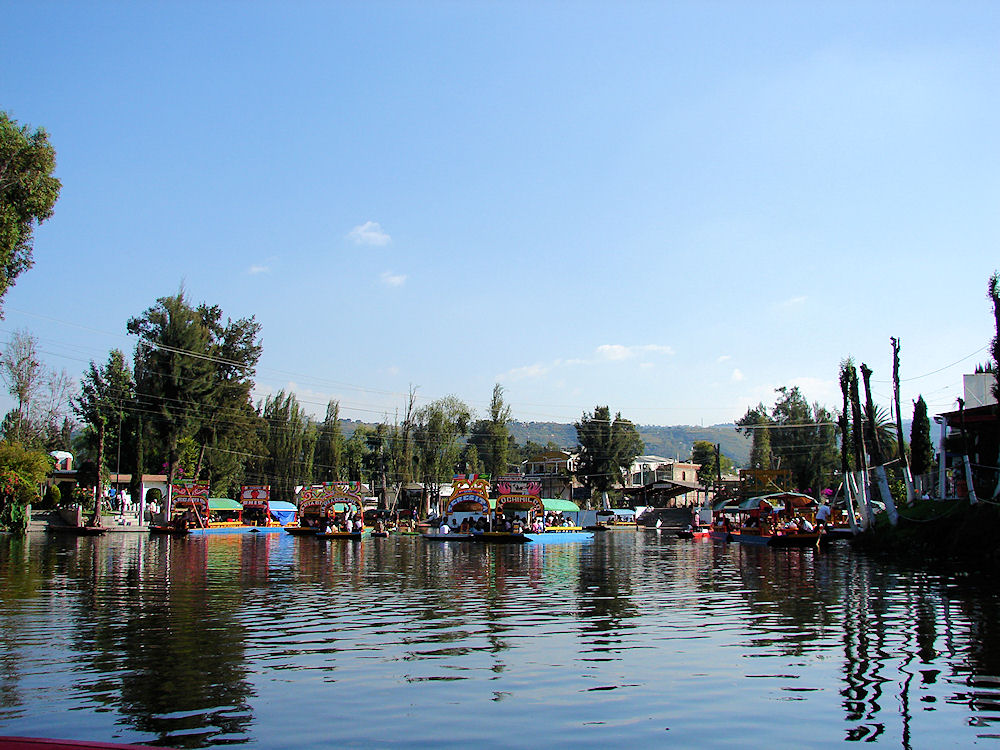Xochimilco's Floating Gardens
Xochimilco, México, D.F. México.
Travel & Tour
Pictures, Photos
Information, Images, & Reviews.
George & Eve DeLange
November 24, 2011.
Google Map To Xochimilco's Floating Gardens, Xochimilco, México, D.F. México.
View Larger Map
We Are Proud Of Our SafeSurf Rating!
Xochimilco's Floating Gardens, Xochimilco, Mexico, D.F. México: We wish to thank Wikipedia, the free encyclopedia for some of the information on this page. We share information with Wikipedia. Xochimilco (so-chee-mil-co) is from the Nahuatl ( nah-wah-tall ) language of the Aztecs. Xochimilco means "garden of flowers". Xochimilco is one of the sixteen delegaciones or boroughs within Mexican Federal District. The Xochimilco borough is centered on the formerly independent city of Xochimilco, which was established on what was the southern shore of Lake Xochimilco in the pre-Hispanic period. Today, the Xochimilco borough consists of the eighteen “barrios” or neighborhoods of this city along with fourteen “pueblos” or villages that surround it, covering an area of about 48 sq miles. While the Xochimilco borough is somewhat in the geographic center of the Federal District, it is considered to be “south” and has an identity separate from the historic center of Mexico City. This is due to its historic separation from that city during most of its history. Xochimilco is best known for its canals, which are left from what was an extensive lake and canal system which connected most of the settlements of the Valley of Mexico. These canals, along with artificial islands called chinampas attract tourists and other city residents to ride on colorful gondola like boats called “trajineras” around its 110 miles of canals. This canal and chinampa system, as a left over vestige of the area’s pre-Hispanic past, has made Xochimilco to become a World Heritage Site in 1987; however, the environmental degradation of both the canals and the chinampas is very severe and currently ongoing, putting the status a World Heritage Site for Xochimilco in question for the future. These Xochimilco canals and gardens are very popular with Mexico City residents as well as tourists. Especially on Sundays! These canals are all of what is left of what used to be a vast lake and canal system that extended over most of the Valley of Mexico, isolating cities such as Tenochtitlan (Mexico City) and Xochimilco to small islands. This system of waterways was the main transportation venue, especially for goods from the pre-Hispanic period until the 20th century. In the pre-Hispanic period, parts of the shallow lakes were filled in, creating canals. Starting in the early colonial period, the interconnected lakes of the valley, including Lake Xochimilco were drained and by the 20th century had shrunk down to a system of canals which still connected Xochimilco with the center of Mexico City. However, with the pumping of underground aquifers since the early 20th century, water tables have dropped, drying canals, and all that are left are the ones in Xochimilco. The canals are fed by fresh water springs, which is artificially supplemented by treated water. This because water tables are still dropping and human expansion and filling in of canals is still occurring, threatening to have the last of these canals disappear despite their importance to tourism Chinampas were invented by the pre-Hispanic peoples of the region around 1,000 year ago as a way to increase agricultural production. On the shallow waters of the lakes, rafts were constructed of juniper branches. Onto these rafts floating on the water, lakebed mud and soil were heaped and crops planted. These rafts, tied to juniper trees, would eventually sink and a new one built to replace it. Over time, these sunken rafts would form square or rectangular islands, held in place in part by the juniper trees. As these chinampa islands propagated, areas of the lake were reduced to canals. These “floating gardens were an important part of the economy of the Aztec Empire by the time the Spanish arrived. Today, only about 5,000 chinampas, all affixed to the lake bottom, still exist in their original form, surrounded by canals and used for agriculture. The rest have become solid ground and urbanized. In the center of Xochimilco, there about 200 chinampas, covering an area of 1,800 hectares. However, one reason the number has decreased is that smaller chinampas have been combined to create larger ones. While there are still those who maintain chinampas correctly, and use them for agriculture, the chinampa culture is fading in the borough with many being urbanized, and being turned into soccer fields, and sites for housing and businesses. Today, as in the past, a large number of small, non-motorized boats and barges float on the waters of the canals. In the past, these boats were mostly used for the transport of goods, but today, they are almost exclusively used for tourism. Not only, are these popular with tourists coming into Mexico City, but also with locals, especially on Sundays. Various types and sizes of boats can be found upon the waters of Xochimilco, but the most common boats are called “trajineras,” which look similar to gondolas, but are modeled after pre-Hispanic vessels called acallis. The current name, trajineras, is an old Spanish word for “canoe.” Originally, trajineras were decorated with floral arches and branches ahuejote juniper trees. This was eventually changed to an arch affixed to a roof, added on for protection from the sun. The arches often have female names on them such s “María” or “Juanita,” which may refer to someone special or is simply the name of the boat. They can be still decorated with flowers but more often they are painted with floral and other designs. Under the trajineras used for tourists, there is a long table with chairs to allow for eating and drinking. Currently there are over two hundred trajineras located in the nine docks or “embarcaderos” that have access to the canals. These nine docks or “embarcaderos” are named: Cuemanco, Caltongo, Fernando Celada, Salitre, Belém, San Cristóbal, Zacapa, Las Flores, Nuevo Nativitas y Belem de las Flores. These docks were originally used for shipping crops from the local fields. Today, they are mostly used for tourists. One of the best-known chinampa in Xochimilco belonged to a man named Julián Santana Barrera, a native of the La Asunción neighborhood. Santana Barrera was a loner, who was rarely seen in most of Xochimilco.He came to fame because he would collect the old broken bodies of dolls from the canals and rubbish tips,and the hang them from branches and tie them to tree trunks. He said that he did this to keep away the evil spirits and to appese the spirt of a dead girl he hed found in the canal a few years before. He would state that he believed that the dolls were somehow still “alive” but “forgotten” by their owners. It was thought that no one lived on this chinampa, but in the early 1990s, when the area was being cleared of excessive water lilies, Santana Barrera was found living there, living in a hut with no services and generally he did not receive visitors, other than his family. The display of the dolls and the doll parts attracted the attention of the press. Eventually, he stated to them that the dolls were there to keep away evil spirits and to help with the harvests in his gardens. His favorite doll was called La Moneca, and he frequently moved the many dolls around among the tree branches of the chinampa. He then began to receive more visitors to see the dolls, which eventually included local political figures. Santana Barrera passed away in 2001. There were many ideas about how he died, some say he drowned himself in the river because he was driven insane. Others say the dolls came alive and killed him. But in fact he just died of old age and while he may not be alive anymore, the dolls are still on the island, accessible by boat. On weekends, sections of the canals are filled with trajineras, and with noisy revelers. You can buy food, drinks and even plants from trajineras that wander the canals and approach the trajineras filled with tourists. Mariachi and other bands also can be hired to play a few songs this way as well.
|



The Mexico City International Airport (Spanish: Aeropuerto Internacional de la Ciudad de México or AICM), also called Benito Juárez International Airport (IATA: MEX, ICAO: MMMX) is the major commercial airport that serves Mexico City, the capital of Mexico. It is also Mexico's and Latin America's busiest airport! We would suggest using this airport if you wish to visit Xochimilco's Floating Gardens, Xochimilco, Mexico, D.F. México. We also would suggest visiting Xochimilco's Floating Gardens as a short side trip, when you are visiting other sites or museums in Xochimilco. It is not that far out of your way!
There are many very good hotels and motels in the area, and if you need a place to stay; Priceline.com can arrange that for you. In fact, we think they are the best way to do it! We have personally, booked flights, hotels, and vacations, through Priceline.com and we can highly recommend them. Their website is very easy to use! We have some links to Priceline.com on this page, since they can arrange all of your air flights, hotels and car. We of course, appreciate your use of the advertising on our pages, since it helps us to keep our pages active. We also have links on this page, that will connect you with several of the best hotels in Mexico City. Hotels that we have personally used! We could, also suggest getting a hotel, and then letting them arrange for either a car, or a tour of Mexico City. If you call their Concierge Services, ahead of your arrival, all of this can be pre-arranged for you. We have used this method, many times, when traveling in Mexico. We have found it to be safe and it works!!! We have never experienced a problem, doing it this way!
|

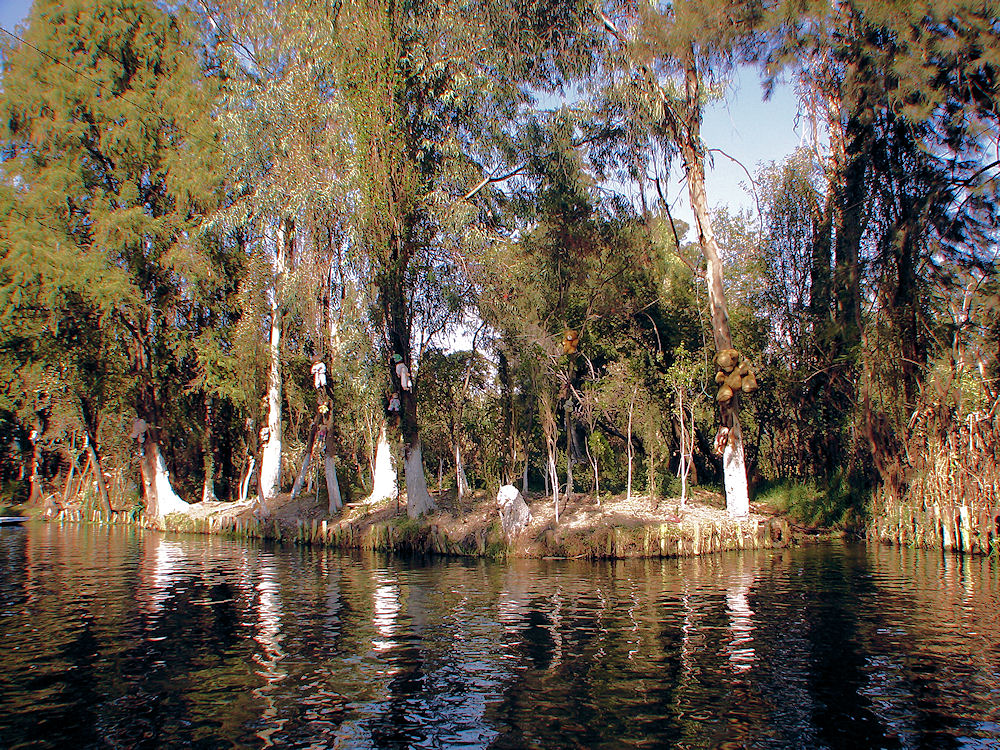 |
| Julián Santana Barrera's Chinampa & It's "Tree Dolls." Xochimilco's Floating Gardens, Xochimilco, Mexico D.F. México. |
|---|
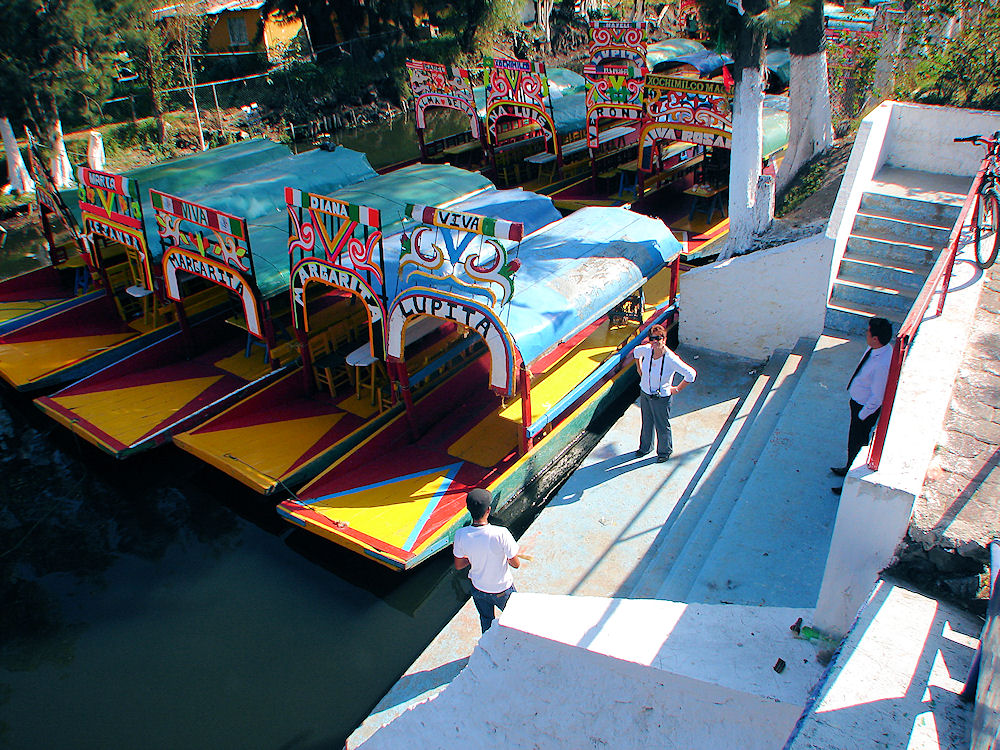 |
| Eve DeLange At The Docks Or Embarcaderos. Xochimilco's Floating Gardens, Xochimilco, Mexico D.F. México. |
|---|
| Xochimilco's Floating Gardens, Xochimilco, Mexico D.F. México. |
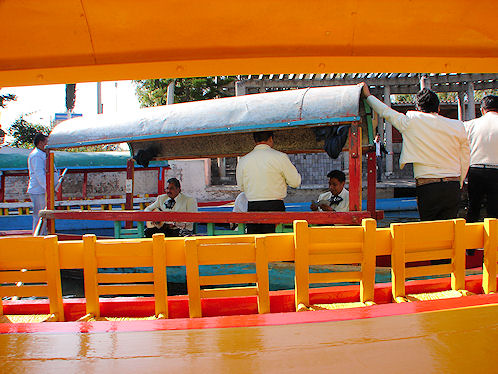 | 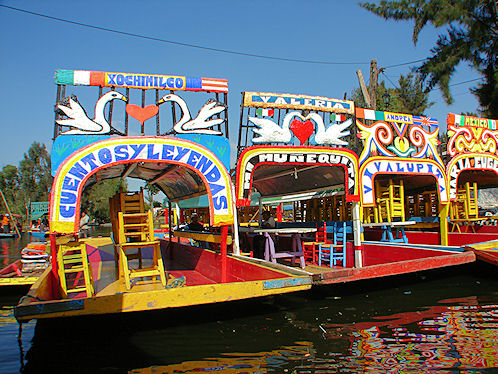 |
| Mariachi Taking A Rest. Xochimilco's Floating Gardens, Xochimilco, Mexico, D.F. México. | Trajineras. Xochimilco's Floating Gardens, Xochimilco, Mexico, D.F. México. |
|---|
Click Here On Links To Great Mexico Hotels.
|
|
|---|
| Click Here To Buy Books About Teotihuacán & Mexico
|
| Back To Mexico City Tours Main Page
|
| Back To Mexico Trips Main Page
|
| Back To DeLange Home Page |







